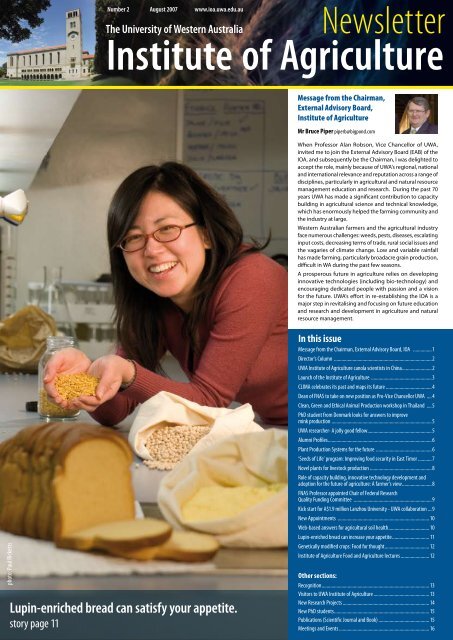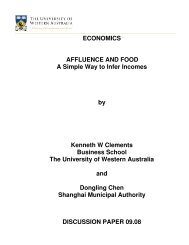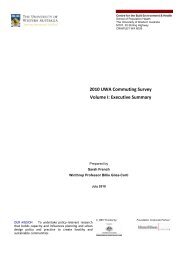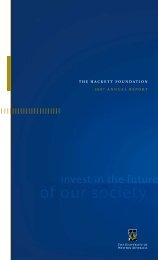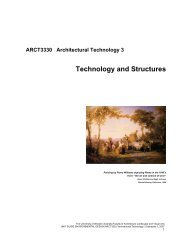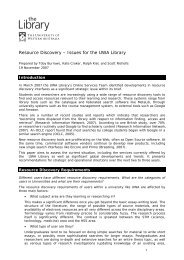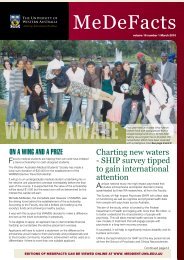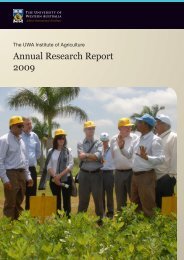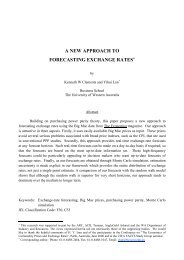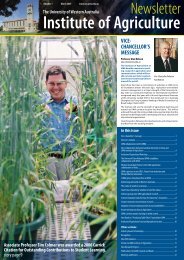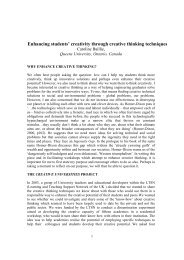Institute of Agriculture - The University of Western Australia
Institute of Agriculture - The University of Western Australia
Institute of Agriculture - The University of Western Australia
You also want an ePaper? Increase the reach of your titles
YUMPU automatically turns print PDFs into web optimized ePapers that Google loves.
Number 2 August 2007 www.ioa.uwa.edu.auNewsletterUWA <strong>Institute</strong> <strong>of</strong> <strong>Agriculture</strong> 1<strong>The</strong> <strong>University</strong> <strong>of</strong> <strong>Western</strong> <strong>Australia</strong><strong>Institute</strong> <strong>of</strong> <strong>Agriculture</strong>Message from the Chairman,External Advisory Board,<strong>Institute</strong> <strong>of</strong> <strong>Agriculture</strong>Mr Bruce Piper piperb@bigpond.comWhen Pr<strong>of</strong>essor Alan Robson, Vice Chancellor <strong>of</strong> UWA,invited me to join the External Advisory Board (EAB) <strong>of</strong> theIOA, and subsequently be the Chairman, I was delighted toaccept the role, mainly because <strong>of</strong> UWA’s regional, nationaland international relevance and reputation across a range <strong>of</strong>disciplines, particularly in agricultural and natural resourcemanagement education and research. During the past 70years UWA has made a significant contribution to capacitybuilding in agricultural science and technical knowledge,which has enormously helped the farming community andthe industry at large.<strong>Western</strong> <strong>Australia</strong>n farmers and the agricultural industryface numerous challenges: weeds, pests, diseases, escalatinginput costs, decreasing terms <strong>of</strong> trade, rural social issues andthe vagaries <strong>of</strong> climate change. Low and variable rainfallhas made farming, particularly broadacre grain production,difficult in WA during the past few seasons.A prosperous future in agriculture relies on developinginnovative technologies (including bio-technology) andencouraging dedicated people with passion and a visionfor the future. UWA’s effort in re-establishing the IOA is amajor step in revitalising and focusing on future educationand research and development in agriculture and naturalresource management.photo: Paul RickettsLupin-enriched bread can satisfy your appetite.story page 11In this issueMessage from the Chairman, External Advisory Board, IOA ................ 1Director’s Column ................................................................................ 2UWA <strong>Institute</strong> <strong>of</strong> <strong>Agriculture</strong> canola scientists in China........................ 2Launch <strong>of</strong> the <strong>Institute</strong> <strong>of</strong> <strong>Agriculture</strong> .................................................. 3CLIMA celebrates its past and maps its future...................................... 4Dean <strong>of</strong> FNAS to take on new position as Pro-Vice Chancellor UWA ..... 4Clean, Green and Ethical Animal Production workshop in Thailand ..... 5PhD student from Denmark looks for answers to improvemink production.................................................................................. 5UWA researcher- A jolly good fellow.................................................... 5Alumni Pr<strong>of</strong>iles.................................................................................... 6Plant Production Systems for the future .............................................. 6‘Seeds <strong>of</strong> Life’ program: Improving food security in East Timor ........... 7Novel plants for livestock production................................................... 8Role <strong>of</strong> capacity building, innovative technology development andadoption for the future <strong>of</strong> agriculture: A farmer’s view........................ 8FNAS Pr<strong>of</strong>essor appointed Chair <strong>of</strong> Federal ResearchQuality Funding Committee ................................................................ 9Kick start for A$1.9 million Lanzhou <strong>University</strong> - UWA collaboration ... 9New Appointments ........................................................................... 10Web-based answers for agricultural soil health................................. 10Lupin-enriched bread can increase your appetite............................... 11Genetically modified crops: Food for thought.................................... 12<strong>Institute</strong> <strong>of</strong> <strong>Agriculture</strong> Food and <strong>Agriculture</strong> lectures........................ 12Other sections:Recognition....................................................................................... 13Visitors to UWA <strong>Institute</strong> <strong>of</strong> <strong>Agriculture</strong>.............................................. 13New Research Projects....................................................................... 14New PhD students............................................................................. 15Publications (Scientific Journal and Book).......................................... 15Meetings and Events.......................................................................... 16
2 UWA <strong>Institute</strong> <strong>of</strong> <strong>Agriculture</strong>Director’scolumnPr<strong>of</strong>essor Kadambot Siddiqueksiddique@fnas.uwa.edu.au<strong>The</strong> IOA was <strong>of</strong>ficially launched on 30thMarch 2007 jointly by Hon. Mr KimChance WA Minister for <strong>Agriculture</strong>and Food; Forestry, the Midwest andWheatbelt and Dr Michael Chaney, AOCITWA, Chancellor, UWA. Pr<strong>of</strong>essorAlan Robson, AM, Vice Chancellor in hisaddress reinforced UWA’s commitmentto agriculture and natural resourcemanagement teaching and research andintent to maintain its premier position atthe regional, national and internationallevels through IOA activities.<strong>The</strong> IOA’s External Advisory Board (EAB)under the Chairmanship <strong>of</strong> Mr BrucePiper met on the morning <strong>of</strong> the launchand discussed the structure, programs,governance and operational plan <strong>of</strong> the<strong>Institute</strong>. <strong>The</strong> EAB provided some usefulfeedback and suggestions on the strategicplan <strong>of</strong> the <strong>Institute</strong>. <strong>The</strong> suggestions willbe incorporated and the strategic planrevised by the next EAB meeting on 28thSeptember 2007.<strong>The</strong> IOA has moved into its new premiseswithin the Faculty <strong>of</strong> Natural and AgriculturalSciences buildings. <strong>The</strong> WA Grower GroupNetwork also operates from the IOApremises.<strong>The</strong> IOA Program Team and ExecutiveGroup commenced their regular meetingsto discuss operational and strategic issues<strong>of</strong> the <strong>Institute</strong>. <strong>The</strong> Animal ProductionSystems Program under the leadership<strong>of</strong> Pr<strong>of</strong>essor Graeme Martin and Dr PhilVercoe met twice and discussed futureactivities. As a result, the IOA’s first Industryforum, “Innovations in Animal Productionto Meet Consumer Expectations”, will beheld at UWA on 2nd August involving some60 representatives invited from industry,growers and the research community.<strong>The</strong> main objectives <strong>of</strong> the forum are: toupdate the latest developments in ‘Clean,Green and Ethical’ (CGE) systems foranimal production; to explore current andfuture animal production systems: farmerand industry perspectives and to identifyfuture directions in markets and consumerrequirements for animal products. <strong>The</strong>industry forum will be <strong>of</strong>ficially opened byPr<strong>of</strong>essor Lyn Beazley, WA Chief Scientist.<strong>The</strong> Plant Production Systems Programunder the leadership <strong>of</strong> Pr<strong>of</strong>essor StephenPowles and Dr Guijun Yan commenced itsactivities in a workshop involving more than50 academic staff and researchers (includingadjunct and honorary appointees) on 2ndJuly.<strong>The</strong> IOA has issued regular press releaseson relevant topics and several stories havebeen taken up by radio (e.g. ABC countyhour) and by the print media. I encourageyou to visit our website for more informationon the IOA’s press releases and otheractivities. Our next public lecture will bedelivered by Pr<strong>of</strong>essor Joachim von Braun,Director General <strong>of</strong> the International FoodPolicy Research <strong>Institute</strong>, Washington, USA.Pr<strong>of</strong>essor von Braun will present a publiclecture on “New forces in the world foodequation: energy, climate, science andeconomics”. I invite you all to attend thisimportant public lecture.Our staff have shown outstandingperformance in attracting several externallyfunded research grants, developinginternational collaboration and producingscientific publications. Pr<strong>of</strong>essor DavidPannell’s prestigious Federation Fellowship,“Integrating economics and sciencefor land, water and biodiversity policy”,will provide the much needed boost inteaching and research activities in this areaat UWA. Recently a number <strong>of</strong> our staffand students received various awards andhonorary positions. <strong>The</strong> IOA’s activities willbe further strengthened with the recentappointments <strong>of</strong> Dr Michael Renton and MrGraeme Doole (both appointments jointlywith CSIRO), and Dr Michael Considine(jointly with Department <strong>of</strong> <strong>Agriculture</strong>and Food <strong>Western</strong> <strong>Australia</strong>) at UWA. Weare also in the process <strong>of</strong> appointing a newDirector for the Centre for Legumes inMediterranean <strong>Agriculture</strong> and a Lecturerposition in Production Agronomy andFarming Systems (Jointly with the GrainsResearch and Development Corporation).I would like to congratulate Pr<strong>of</strong>essorAlistar Robertson, Dean FNAS on his newappointment as the Pro Vice-Chancellor(Research Initiatives) at UWA. Pr<strong>of</strong>essorRobertson played a significant role inestablishing the IOA and providing strategicdirections.I hope that you will find the articles in thisnewsletter <strong>of</strong> interest. <strong>The</strong> IOA welcomesfeed back and contributions to futurenewsletters. We are particularly keen to hearfrom growers, industry and the alumni.UWA <strong>Institute</strong> <strong>of</strong> <strong>Agriculture</strong> canola scientists in ChinaRapeseed (canola) is a major industry inChina and UWA researchers were thererecently to promote collaboration withtheir Chinese associates in rapeseedbreeding, pathology and agronomy.<strong>The</strong> visit was part <strong>of</strong> an internationalproject funded by the <strong>Australia</strong>n Centrefor International Agricultural Research(ACIAR) and the Grains Researchand Development Corporation(GRDC) entitled “Oilseed BrassicaImprovement in China, India and<strong>Australia</strong>”. More than 30 collaboratorsfrom <strong>Australia</strong>, China and India met atthe leading Chinese rapeseed researchlaboratory at Huazhong Agricultural<strong>University</strong>, Wuhan, Hubei Province, inearly April.<strong>The</strong> UWA delegation to the ACIAR projectmeeting included Assoc Pr<strong>of</strong>s WallaceCowling and Martin Barbetti, Senior LecturerDr Guijun Yan, Research Associate Dr ShengChen and Research Fellow Dr Ping Si, fromthe UWA School <strong>of</strong> Plant Biology and Centrefor Legumes in Mediterranean <strong>Agriculture</strong>(CLIMA).One major outcome <strong>of</strong> the ACIAR/GRDCproject has been exchange <strong>of</strong> Brassicanapus and Brassica juncea varieties between<strong>Australia</strong>, China and India. UWA’s Dr Li, Pr<strong>of</strong>Sivasithamparam and Assoc Pr<strong>of</strong> Barbettihave been assessing Chinese rapeseedgermplasm for resistance to Sclerotinia,white rust and blackleg diseases and DrChen and Assoc Pr<strong>of</strong> Cowling have beenassessing genetic distance and uniqueness<strong>of</strong> rapeseed germplasm and hybrid vigourin crosses between <strong>Australia</strong>n, Chineseand Indian lines.It is not widely recognized that 50% <strong>of</strong><strong>Australia</strong>’s canola ancestry comes fromAsian rapeseed varieties introduced in thelate 1960s to <strong>Australia</strong>. <strong>The</strong>re has alreadybeen a big influence <strong>of</strong> Asian varieties in<strong>Australia</strong> and this will continue. Chinesescientists have been developing hybridcanola varieties for more than twodecades, and China grows more hybridcanola than the total <strong>Australia</strong>n canolacrop. Chinese scientists have developedSclerotinia resistance over many years. Wecan greatly benefit from collaboration withleading Chinese rapeseed scientists.
Launch <strong>of</strong> the <strong>Institute</strong> <strong>of</strong> <strong>Agriculture</strong>UWA <strong>Institute</strong> <strong>of</strong> <strong>Agriculture</strong> 3Nearly 70 years after it was originallyestablished, the <strong>University</strong>’s <strong>Institute</strong> <strong>of</strong><strong>Agriculture</strong> (IOA) has been reinvigoratedto ensure integration <strong>of</strong> agricultural andresource management education, trainingand research at UWA and strengthencollaboration and interaction with therural community and industry.More than 200 people from UWA, researchinstitutions and other sectors <strong>of</strong> theagricultural industry, gathered to celebratethe <strong>of</strong>ficial re-establishment <strong>of</strong> the new IOAon March 30, 2007. <strong>The</strong> day commencedwith the inaugural meeting <strong>of</strong> the ExternalAdvisory Board and was followed by the<strong>of</strong>ficial launch, including the unveiling <strong>of</strong> acommemorative plaque. <strong>The</strong> day concludedwith a social event at the UWA <strong>University</strong>Club.At the launch, UWA’s number one agriculturalscientist, the Vice-Chancellor, Pr<strong>of</strong>essorAlan Robson, said the <strong>Institute</strong> would bringtogether many <strong>of</strong> the <strong>University</strong>’s researchstrengths into one centre and providea better vehicle for the coordination <strong>of</strong><strong>University</strong> and industry collaborations.<strong>Institute</strong> Director, Pr<strong>of</strong>essor KadambotSiddique, spoke <strong>of</strong> the future for agricultureat UWA, saying the <strong>Institute</strong> vision is tobecome an internationally recognisedscientific research leader, focusing andenhancing the intellectual capacityneeded to tackle industry issues in theagricultural sectors at regional, national andinternational level.<strong>The</strong> <strong>Institute</strong> has been established inpartnership with the Schools <strong>of</strong> Agriculturaland Resource Economics, Animal Biology,Earth and Geographical Sciences, PlantDr Michael Chaney, Chancellor, UWA and the Hon. Mr Kim Chance, WA Minister for <strong>Agriculture</strong>, Forestry and Fisheries, unveilthe commemorative plaque at the launch <strong>of</strong> the IOA.Biology and relevant research centres withinthe Faculty <strong>of</strong> Natural and AgriculturalSciences and other Faculties at UWA.Pr<strong>of</strong>essor Siddique said strategic approachesfor agricultural research and developmentshould target improved technologiesfor increased and pr<strong>of</strong>itable productionand sustainable conservation <strong>of</strong> naturalresources.A highly supportive environment forundergraduate and post-graduateprograms, linked to the industry and crossinstitutionalsupervision, was essential toappropriately train future generations <strong>of</strong>agricultural scientists in <strong>Australia</strong>. UWA hada major role to play in this regard.IOA staff Ms Angela Fielder, Personal Assistant, Pr<strong>of</strong>Kadambot Siddique, Director, and Ms Kerry Regan,Communications Officer at the launch.ACIAR delegates from <strong>Australia</strong>, China and India at the world’s largest dam, Three Gorges, on the Yangtze River.
4 UWA <strong>Institute</strong> <strong>of</strong> <strong>Agriculture</strong>CLIMA celebrates its past and maps its futureDr Ping Si pingsi@cyllene.uwa.edu.auA special forum was held on May 31,2007 to celebrate past achievements andmap future directions for the Centre forLegumes in Mediterranean <strong>Agriculture</strong>(CLIMA). From July 2007, CLIMA is a UWAResearch Centre within the Faculty <strong>of</strong>Natural and Agricultural Sciences. CLIMAwas established in 1992 as a CooperativeResearch Centre (CRC) with Department<strong>of</strong> <strong>Agriculture</strong> <strong>Western</strong> <strong>Australia</strong>(DAFWA), Commonwealth Scientific andIndustrial Research Organisation (CSIRO)and Murdoch <strong>University</strong> as researchpartners. It became a research alliancein 2001 and finally a UWA Centre in July2007. <strong>The</strong> three phases are referred to asCLIMA 1, CLIMA 2 and CLIMA 3.<strong>The</strong> celebratory event included a half dayforum, release <strong>of</strong> the 2005-06 biennialresearch report, CLIMA Board meeting,Industry Advisory Group meeting and adinner. <strong>The</strong> forum, titled ‘CLIMA: Past,Present and Future’, was the highlight. It waschaired by the Dean <strong>of</strong> the FNAS, Pr<strong>of</strong> AlistarRobertson and opened by Pr<strong>of</strong> Alan Robson,Vice Chancellor <strong>of</strong> UWA and foundingDirector <strong>of</strong> CLIMA, the forum. He recalledthat CLIMA 1 was the first CRC at UWA. Pr<strong>of</strong>Robson reiterated UWA’s commitment tothe business <strong>of</strong> CLIMA 3.Researchers from partner organisationspresented their CLIMA 2 achievementsat the forum. An impressive array <strong>of</strong> newcultivars <strong>of</strong> pulses and annual pasturelegumes for various environments havebeen released to the farming community.Future lupin varieties will incorporatethe substantial improvement made inCLIMA 2 achievements were presented at a celebratory forum.lupin germplasm from thin seed coat,better grain quality, greater proteinconcentrations and herbicide tolerance. Acombination <strong>of</strong> molecular, tissue cultureand field screening techniques have beenused to improve germplasm, understandadaptation and utilise germplasmresources in lupin, chickpea and pasturespecies. Retiring CLIMA Director, Pr<strong>of</strong> NeilTurner highlighted research activities thatwill be continued in CLIMA 3, includingthe new generation <strong>of</strong> molecular toolsbeing explored for application in legumebreeding. Forum presentations can beviewed and listened to at the CLIMA website(www.clima.uwa.edu.au).This forum drew together people associatedwith CLIMA for the past 15 years, includingphoto: Julia Wilsonthe five Directors, Pr<strong>of</strong> Alan Robson,Dr John Hamblin, Assoc. Pr<strong>of</strong> Mike Ewing,Pr<strong>of</strong> Kadambot Siddique and Pr<strong>of</strong> Neil Turner.<strong>The</strong>re were about 80 people in attendancefrom UWA, DAFWA, CSIRO, Murdoch<strong>University</strong>, Curtin <strong>University</strong>, ChemistryCentre, Department <strong>of</strong> Fisheries WA,CLIMA Industry Advisory Group members,Pulse <strong>Australia</strong>, the Council <strong>of</strong> GrainGrower Organisation (COGGO) and GrainsResearch and Development Corporation(GRDC). GRDC Managing Director, PeterReading, and GRDC Board Chairman, TerryEnright, also attended the forum and dinner.Attendees were impressed with CLIMA 2’sachievements, organisation <strong>of</strong> the forumand the contribution <strong>of</strong> CLIMA staff for thisspecial day.Dean <strong>of</strong> FNAS to take on new position as Pro-Vice Chancellor at UWAPr<strong>of</strong>essor Alistar Robertson has been appointed Pro Vice-Chancellor (ResearchInitiatives) at UWA. Currently Dean <strong>of</strong> the Faculty <strong>of</strong> Natural and Agricultural Sciences(FNAS), he starts his new role in January 2008.Pr<strong>of</strong>essor Robertson has been FNAS Dean since 2003 and his vision and leadership hascontributed enormously to the Faculty successfully attracting substantial new researchincome and students (undergraduates and post-graduates), and enhancing its internationalreputation.Announcing the appointment, UWA Vice Chancellor Pr<strong>of</strong>essor Alan Robson, said “As ProVice-Chancellor (Research Initiatives), Pr<strong>of</strong> Robertson will act as a focal point externallyand internally to foster collaborative research relationships with partners in the privateand public sector, particularly in the environment area. He will also work with the DeputyVice-Chancellor (Research and Innovation) and the Pro Vice-Chancellor (Research andResearch Training) to enhance the research performance <strong>of</strong> the <strong>University</strong>”.In particular, Pr<strong>of</strong> Robertson will be responsible for early career mentoring, promotingmore applications and grants within the ARC Linkage scheme and greater interaction withindustry. He will also Chair the Associate Deans <strong>of</strong> Research Committee to deliver whole<strong>of</strong>-<strong>University</strong>performance improvements.<strong>The</strong> position provides great opportunities to build and strengthen the <strong>University</strong>’s researchpartnerships and develop a whole-<strong>of</strong>-<strong>University</strong> approach to ensure research excellencethroughout the <strong>University</strong>.
UWA <strong>Institute</strong> <strong>of</strong> <strong>Agriculture</strong> 7‘Seeds <strong>of</strong> Life’ program: Improving food security in East TimorAdj Pr<strong>of</strong>essor Harry Nesbitth.nesbit@bigpond.net.auAlex Dalley, Seed <strong>of</strong> Life-East Timor research advisor (rear right) and farm leader (in front <strong>of</strong> Alex Dalley) show Philip Young(technical advisor, left), Tony Fischer (ACIAR, right) and Seeds <strong>of</strong> Life technical personnel seed production <strong>of</strong> the newlyreleased Nakroma rice.<strong>The</strong> ‘Seeds <strong>of</strong> Life’ Program, whichcommenced in 2005, addresses foodsecurity issues in the rural areas <strong>of</strong> EastTimor. <strong>The</strong> major aims are to improvethe capacity for East Timor to releaseand distribute improved varieties <strong>of</strong> keyfood crops. Major crops currently beingresearched are maize, rice, cassava,sweet potato and peanut, althougheffort is also put into improved pigeonpea and cultivating ancillary crops suchas velvet bean.‘Seeds <strong>of</strong> Life’ is a Ministry <strong>of</strong> <strong>Agriculture</strong>Forestry and Fisheries (MAFF) programsupported by <strong>Australia</strong> with funding fromthe <strong>Australia</strong>n Agency for InternationalDevelopment and the <strong>Australia</strong>n Centrefor International Agricultural Research.<strong>The</strong> <strong>Australia</strong>n funding is managed byUWA through the Centre for Legumes inMediterranean <strong>Agriculture</strong>. <strong>The</strong> currentphase <strong>of</strong> ‘Seeds <strong>of</strong> Life’ consolidates thegains made by a previous three year ACIARProject which ended in 2003.During the previous phase, improvedgermplasm imported from crop centresbelonging to the Consultative Group onInternational Agricultural Research (CGIAR)were evaluated on research stations. <strong>The</strong>best varieties are now being cultivated infarmers’ fields with more than 1600 onfarmtrials started in the past two seasons.CGIAR centres continue to provide theirlatest appropriate breeding material forevaluation under East Timor conditions inthe search for a wide range <strong>of</strong> crop varietyoptions.Yield improvements over locally availablecrop varieties were impressive in researchstation trials. Maize yields <strong>of</strong> modern yellowmaize composites were double those <strong>of</strong>locals. A similar result was achieved withintroduced sweet potatoes. Some moderncassava clone yields were approximately50% higher than locally grown varietiesand newer peanuts had larger seed size.Two years <strong>of</strong> on-farm trials illustrated thatthe yield advantage on research stationswas also reflected in farmers’ fields. Underfarm conditions and farmer managementpractices, the new varieties continued toexpress their superior yield advantage. Infact the yield advantage <strong>of</strong> growing thenewer varieties was up to 50% greaterfor rice at low altitudes and 48% greaterfor peanuts across 168 on-farm trials.Three sweet potato varieties had a yieldadvantage <strong>of</strong> 140% over local varieties inon-farm trials.Farmer taste and acceptability evaluationsconducted during field days and from anearly adoption survey were quick to pointout the advantages and disadvantages <strong>of</strong> thenew crop varieties. Some farmers preferredthe milling and storage characteristics<strong>of</strong> traditional white varieties comparedwith yellow maize and the newer sweetpotatoes grew so large that the soil crackedallowing termites to enter the tubers if notharvested early. Acceptability is high, withmost farmers re-planting the crops afterharvesting their on-farm trial plots.In March, 2007 the MAFF formed a VarietalRelease Committee, which discussed theresults <strong>of</strong> replicated trials and on-farmtesting before releasing seven new varieties.<strong>The</strong>se included two maize, one paddy rice,one peanut and three sweet potato varieties.<strong>The</strong> challenge now is multiplying sufficientseed and planting material to keep pacewith the farmers’ high demand.Dr Simon McKirdyCEO, CRC for National Plant BiosecurityI completed a Bachelor <strong>of</strong> Science in<strong>Agriculture</strong> at UWA in 1987 and a PhDin 1997. My PhD thesis examined therole <strong>of</strong> alternative hosts in the survival<strong>of</strong> seed-borne viruses infecting pasturelegumes and lupins and the spread <strong>of</strong>contact-transmitted viruses in southwestWA and was supervised by Pr<strong>of</strong>.Sivasithamparam.After graduating in 1987, I worked as aTechnical Officer with the Department <strong>of</strong> <strong>Agriculture</strong> and Food<strong>Western</strong> <strong>Australia</strong>n (DAFWA). In 1991 I began the first <strong>of</strong> severalResearch Officer roles with DAFWA investigating the impact andmanagement <strong>of</strong> plant viruses on grain crops.In June 1996 I became a Senior Research Officer with the Centrefor Legumes in Mediterranean <strong>Agriculture</strong> (CLIMA), UWA. In 1998 Irejoined DAFWA as a plant pathologist and broadened my skills byworking on a range <strong>of</strong> plant pathogens and numerous horticulturalcrops, including a role as the Quarantine Plant Pathologist for WA.This role introduced me to the world <strong>of</strong> plant biosecurity andgovernment policy, both state and national.In 2002 I moved to Canberra to join Plant Health <strong>Australia</strong> in a policy/process role. <strong>The</strong> successful bid to create the CRC for National PlantBiosecurity gave me the opportunity in 2005 to return to research.This is a challenging role involving participants from all around<strong>Australia</strong> and strong links with international researchers in variouscountries. One <strong>of</strong> the strong points with any CRC and one I findsatisfying is training the next generation <strong>of</strong> scientists. It is alsopositive that UWA is involved in this CRC.My decision to explore a role in agricultural science has been veryrewarding. <strong>The</strong> different roles have been enjoyable and providedreal opportunities to benefit growers.
8 UWA <strong>Institute</strong> <strong>of</strong> <strong>Agriculture</strong>Role <strong>of</strong> capacity building, innovative technology developmentand adoption for the future <strong>of</strong> agriculture: A farmer’s viewMr Rob Hydemarkhyde@jameson.com.auI believe a successful agricultural industryshould have an all-embracing educationand technology capable <strong>of</strong> leading it t<strong>of</strong>uture prosperity and that this starts witha healthy mind that is educated to alsopursue the right political decisions.At every level it is a matter <strong>of</strong> “training us allsufficiently” in the knowledge that we willnot know it all and that we must continueto seek the very best people to assist us inthe many areas <strong>of</strong> our business. Those fewyears students spend at university must alsoequip them with the right understandingand attitudes to continue to seek andachieve logical answers.Unfortunately, farmers too <strong>of</strong>ten arriveat crossroads for all family membersdependent on their farm because <strong>of</strong>inadequate planning at the family level.<strong>The</strong>y can <strong>of</strong>ten end up in a situation wherethey must sell and a distribution <strong>of</strong> assetswill not replace the business for even theparents. <strong>The</strong>re is a tragic lack <strong>of</strong> commercialreality these days and <strong>Australia</strong>n farmerscan’t continue like this.Mr Rob Hyde, farmer, Wongan Hills, WAIt’s interesting to study how machineryagents have risen from this situation overthe last 50 years. <strong>The</strong>y have been guidedby the large manufacturers to ensurepr<strong>of</strong>itable returns, while faced with thesame agriculture vagaries <strong>of</strong> the weatheras the farmers. This is happening withall rural towns, particularly in the area <strong>of</strong>groceries and, in almost all cases, the sizeand turnover or specialisation is an obviousfactor ensuring viability.<strong>University</strong> graduates with excellent technicalknowledge and good communication skillsare required to demonstrate to growers thatturnover and competition are importantingredients towards pr<strong>of</strong>itability. Sadly, wehave recently received news that the wheatindustry is still in total chaos about how tomarket the crop. Where to from here - whoknows?I believe the greatest opportunities will comefrom those people between 30 and 60 whoare still in rural areas, are still in the industry,started with a <strong>University</strong> background andhave the understanding that access tocorrect information is the most important<strong>of</strong> all ingredients, after energy and honestytowards themselves. Just how you getprogressive policies into grower bodiescontrolled largely by people who shouldbe enjoying freedom from managementand making use <strong>of</strong> the workbench in thegarage is a challenge for everyone involvedin agriculture. UWA’s <strong>Institute</strong> <strong>of</strong> <strong>Agriculture</strong>has a significant role in addressing some <strong>of</strong>the above issues.Novel plants for livestock productionDr Phil Vercoepvercoe@cyllene.uwa.edu.au<strong>The</strong> International Atomic Energy Agency(IAEA) is referred to as the “Atoms forPeace” Agency and was establishedunder the United Nations umbrella<strong>of</strong> organisations in 1957 to promotesafe, secure and peaceful nucleartechnologies.One <strong>of</strong> the IAEA’s six Departments, theDepartment <strong>of</strong> Nuclear Sciences andApplications, deals with the application <strong>of</strong>nuclear technologies in food and agriculture,human health, water resource managementand environmental monitoring, researchand protection. Within this Departmentthere is a Division coordinating a jointprogramme with the Food and AgriculturalOrganisation (FAO) that deals with nucleartechniques in food and agriculture.I spent last year in the Animal Productionand Health Section within the Joint FAO/IAEA Division at Vienna, Austria wherethe main objective is to “enhance foodsecurity by supporting sustainable livestockproduction systems in developing countriesthrough strategic and applied research,technology transfer and capacity building”.<strong>The</strong>y achieve this through a combination<strong>of</strong> Co-ordinated Research Projects (CRP),which bring together researchers in bothdeveloping and industrialised countriesto solve a problem <strong>of</strong> common interest,and Technical Co-operation Projects(TCP), where there is a transfer <strong>of</strong> proventechnology (<strong>of</strong>ten developed in CRP) toMember States.<strong>The</strong> main reason I approached the Agencyto work at the Joint Division was to organizeand coordinate a meeting <strong>of</strong> experts in thefield <strong>of</strong> screening native plant resourcesfor alternatives to chemicals in livestockproduction. Through the support andnetworks <strong>of</strong> the Animal Production andHealth Section I coordinated a meetingtitled ‘Alternative feed resources: a keyto livestock intensification in developingcountries’. <strong>The</strong> meeting was held incooperation with Writtle College (UK), whichhosted the British Society <strong>of</strong> Animal Sciencemeeting on ethnobotany/ethnoveterinarymedicine.Ten internationally recognised experts inthis area attended the meeting where wereviewed the opportunities and challengesassociated with in-vitro screening <strong>of</strong> plantsfor bioactive properties, using feedingbehaviour for developing systems thatintegrate novel plants and extracts int<strong>of</strong>eeding systems, identifying opportunitiesfor technical and research projects forincreasing the scope <strong>of</strong> the plant screeningactivities and developing integrated feedingsystems for livestock production that arepr<strong>of</strong>itable and environmentally safe.We now have a global network <strong>of</strong> researchersinterested in standardising screeningprocedures and taking the opportunity tocollaborate on a global scale. <strong>The</strong> Joint FAO/IAEA remains the key link in this network butprovides opportunities for the collaborationto continue.<strong>The</strong>re were many other positive aspectsto my year at the IAEA, not least theexposure <strong>of</strong> UWA’s links into global issuesin agriculture, particularly those relatedto livestock production in developingcountries. Many <strong>of</strong> the issues in livestockproduction in these developing countriesreflect very closely the problems <strong>of</strong> seasonalfluctuations in the quantity and quality <strong>of</strong>feed resources we have in <strong>Australia</strong> andthe need to find alternative feed resourcesand a way to utilise them effectively. Formore information about the activities <strong>of</strong>the Animal Production and Health Sectionplease visit their website:http://www-naweb.iaea.org/nafa/aph/topic-animal-health.html
UWA <strong>Institute</strong> <strong>of</strong> <strong>Agriculture</strong> 9Kick start for A$1.9 million Lanzhou <strong>University</strong> - UWA collaborationResearchers from UWA’s <strong>Institute</strong><strong>of</strong> <strong>Agriculture</strong> (IOA) visited China’sLanzhou <strong>University</strong> in May 2007 tocommence a newly funded A$1.9 millioncollaborative project on “<strong>The</strong> sustainabledevelopment <strong>of</strong> agricultural systemsin dry and cold eco-systems <strong>of</strong> LoessPlateau”. <strong>The</strong> project’s main objective isto train researchers and post-graduatestudents (capacity building) in the study<strong>of</strong> environmental characterisation <strong>of</strong> dryand cold eco-systems, development <strong>of</strong>improved crop and pasture productiontechnologies and animal husbandrypractices and long term strategies toadapt to climate change using westChina as a model.UWA participants in the project, Pr<strong>of</strong>.Kadambot Siddique, Director <strong>of</strong> IOA, Pr<strong>of</strong>.Neil Turner former Director <strong>of</strong> CLIMA andDr Guijun Yan, Senior Lecturer and DeputyLeader <strong>of</strong> Crop Production Systems Program<strong>of</strong> IOA, gave eight seminars to more than 300staff, postgraduates and undergraduateson several topics, including research andmanagement <strong>of</strong> dryland agriculture andgenetics and breeding <strong>of</strong> dryland crops andpastures. <strong>The</strong>y also visited the GrasslandResearch Station <strong>of</strong> Lanzhou <strong>University</strong> andYellow River water management systemproject <strong>of</strong> Gansu Province.Dr Guijun Yan, Senior Lecturer and Deputy Leader <strong>of</strong> Crop Production Systems Program <strong>of</strong> IOA, Pr<strong>of</strong>. Kadambot Siddique,Director <strong>of</strong> IOA, Pr<strong>of</strong>. Hui Gan, Vice President <strong>of</strong> Lanzhou <strong>University</strong>, Pr<strong>of</strong>. Neil Turner, former Dir. <strong>of</strong> CLIMA and Pr<strong>of</strong>. NanZhibiao, Dean <strong>of</strong> the College <strong>of</strong> Pastoral Agricultural Science, when the three UWA staff were made Guest Pr<strong>of</strong>essors atLanzhou <strong>University</strong>.Pr<strong>of</strong>. Fengmin Li, Director <strong>of</strong> the National Keylaboratory <strong>of</strong> Arid and Grassland Ecologywill visit UWA in late September, 2007 andPr<strong>of</strong>. Ruijun Long <strong>of</strong> the same laboratory willhave a three month sabbatical visit at UWAlater this year. Ten current Masters studentswere introduced to the delegation andencouraged to apply for UWA InternationalPostgraduate Research Scholarship (IPRS) orspecial scholarships <strong>of</strong>fered to China’s ‘985’university graduates. A Memorandum <strong>of</strong>Understanding between UWA and Lanzhou<strong>University</strong> was recently signed to reinforcethe mutual commitment. To expand andmaintain this collaboration, Pr<strong>of</strong>essorsSiddique and Turner and Dr Yan wereappointed Honorary Pr<strong>of</strong>essors <strong>of</strong> GansuAcademy <strong>of</strong> Agricultural Sciences, AdjunctPr<strong>of</strong>essors <strong>of</strong> the National Key Laboratory<strong>of</strong> Arid and Grassland Ecology, and GuestPr<strong>of</strong>essors <strong>of</strong> Lanzhou <strong>University</strong>.FNAS Pr<strong>of</strong>essor appointed Chair <strong>of</strong> Federal ResearchQuality Funding CommitteeEmeritus Pr<strong>of</strong>essor David Lindsay, an honorary senior research fellow in the Faculty<strong>of</strong> Natural and Agricultural Sciences (FNAS), was recently appointed by the Hon.Minister <strong>of</strong> Education, Ms Julie Bishop, to one <strong>of</strong> 13 chairs <strong>of</strong> review panels for theResearch Quality Funding exercise, which begins in earnest next year. He chairs thepanel responsible for assessing the quality <strong>of</strong> research into agricultural, veterinary,environmental and food sciences in <strong>Australia</strong>n universities. This, <strong>of</strong> course, includesa large part <strong>of</strong> what FNAS is about. However, very strict conflict-<strong>of</strong>-interest rules willmean that assessment <strong>of</strong> the FNAS submissions - assuming there are some - will behandled by someone else.<strong>The</strong> program, which is being directed by the federal Department <strong>of</strong> Education, Scienceand Training (DEST) is in its early stages. <strong>The</strong> review panels, each comprising 12 eminentscientists, are still being selected from a huge number <strong>of</strong> nominees. Only the chairs havebeen announced and the balance will be known in September. While this is going on, DESTis conducting trials in some areas <strong>of</strong> selected universities to ‘iron out’ as many potentialglitches in the process as possible. Guidelines, specific to individual panels, are being drawnup. Most universities, including UWA, have already begun collating data on publicationsand research outputs ready for the detailed submissions that will be called for towards theend <strong>of</strong> 2007, with a deadline <strong>of</strong> April 2008. <strong>The</strong> 13 panels will then begin the massive task<strong>of</strong> evaluating these submissions to assess the quality and impact <strong>of</strong> the research done ineach <strong>of</strong> the research groups from the universities and will report in late 2008.Emeritus Pr<strong>of</strong>essor David Lindsay<strong>The</strong> Federal Government plans to use these assessments to apportion a significantproportion <strong>of</strong> its funding to universities during the following four years, so the RQF exerciseis one to be taken seriously and FNAS needs to present its considerable achievements inthe best possible light.
10 UWA <strong>Institute</strong> <strong>of</strong> <strong>Agriculture</strong>Web-based answers for agricultural soil healthMs Jessica SheppardFarmers can better understand their soilhealth through a new and interactiveweb-based tool developed through theAvon Catchment Council’s Soil Qualitymonitoring program and being deliveredby UWA and Department <strong>of</strong> <strong>Agriculture</strong>and Food <strong>Western</strong> <strong>Australia</strong> (DAFWA).Launched in March 2007 by Dr DanielMurphy, head <strong>of</strong> the soil biology group atUWA, the site is designed to raise awareness<strong>of</strong> the health <strong>of</strong> agricultural soil across thestate. It will provide useful information t<strong>of</strong>armers to aid their management <strong>of</strong> on farmsoil health issues.<strong>The</strong> website provides the basis for adatabase <strong>of</strong> locally validated and qualityassured benchmarks for soil health fromapproximately 900 paddocks across WA.Soil analysis results are available for 0 to10cm or to a depth <strong>of</strong> 30cm dependingon the soil parameter being investigated.Farmers can access information aboutchemical, physical and biological soilparameters in their own area and comparetheir own soil test results with averages inthe region and across the state.<strong>The</strong> site can relate soil properties such as soilorganic carbon with biological indicatorssuch as microbial biomass and providesa range <strong>of</strong> fact sheets on the soil qualityparameters reported. It also provides toolsto assess potential yield, based on rainfalland a calculator to assess potential benefits/costs <strong>of</strong> a green manure phase.Presentations from the WA Soil Health Forum,Dr Daniel Murphy, UWA and Dr Andrew Wherret, DAFWA are shown the Soil Quality website by designer Jordan Brock.held in March 2007, are also accessible fromthe site and cover many relevant topics,including results <strong>of</strong> long-term soil aciditymonitoring, the role <strong>of</strong> organic matter insoil and inoculant use in <strong>Australia</strong>.<strong>The</strong> Soil Quality website,www.soilquality.org.au. has been developedthrough a collaborative project delivered byUWA and DAFWA in conjunction with theAvon Catchment Council, Land and Water<strong>Australia</strong>, Grains Research and DevelopmentCorporation and the South Coast NaturalResource Management Inc. It is a result <strong>of</strong>investment from the State and <strong>Australia</strong>nGovernment through the National ActionPlan for Salinity and Water Quality. For furtherinformation, contact Dr Daniel Murphy atdmurphy@cyllene.uwa.edu.au.New Appointments at the <strong>Institute</strong> <strong>of</strong> <strong>Agriculture</strong>Mr Graeme Doolebegan as a lecturerin the School<strong>of</strong> Agriculturaland ResourceEconomics (SARE)in February 2007after recentlycompleting hisdoctoral thesis.He shifted fromNew Zealand inmid-2003 to study for a doctorate atthe School <strong>of</strong> Agricultural ResourceEconomics, UWA, given its reputationfor rigorous applied economic analysis.His thesis investigated the combinedvalue <strong>of</strong> lucerne pasture for herbicideresistance and water table managementin WA dryland agriculture and involveddeveloping and implementing a variety<strong>of</strong> innovative mathematical modellingtechniques. This analysis was co-supervisedby Pr<strong>of</strong>essor David Pannell and Dr ClintonRevell <strong>of</strong> the Department <strong>of</strong> <strong>Agriculture</strong> andFood (<strong>Western</strong> <strong>Australia</strong>) and jointly fundedby the Cooperative Research Centre (CRC)for Plant-Based Management <strong>of</strong> DrylandSalinity and the CRC for <strong>Australia</strong>n WeedManagement. Graeme’s lecturing position isa dual appointment with CSIRO SustainableEcosystems, which has opened up excitingopportunities for collaboration with some<strong>of</strong> <strong>Australia</strong>’s leading scientists, particularlyin the area <strong>of</strong> farming systems research.Graeme is also the Deputy Leader <strong>of</strong> theRural Economy, Policy and DevelopmentProgram within the <strong>Institute</strong> <strong>of</strong> <strong>Agriculture</strong>.In his spare time, Graeme enjoys watchingNew Zealand teams win rugby matches(and, hopefully, the World Cup), reading,and snorkelling.Dr Michael Rentonhas been appointedto a lecturing positionin Plant Biology in thearea <strong>of</strong> Agro-ecologymodelling. He willwork closely withthe WA HerbicideResistance <strong>Institute</strong>(WAHRI) on herbicideresistance and weedpopulation dynamics modelling. For thelast two years he has been working withthe Department <strong>of</strong> <strong>Agriculture</strong> and Food<strong>Western</strong> <strong>Australia</strong> on a Weed CooperativeResearch Centre project developing asimulation model <strong>of</strong> weed seedbankpopulation dynamics called the “Weed SeedWizard”. He has also worked as a lecturerin mathematics at UWA and Murdochin 2005 and completed a post-doctoralresearch project in constructing stochastic
Lupin-enriched bread can satisfy your appetiteDr Jonathan Hodgsonjonathan.hodgson@uwa.edu.auObesity is now a major public health problem worldwide. Manystrategies have been proposed to fight the obesity epidemicand associated health risks.One possible strategy involvesunderstanding the role <strong>of</strong> dietarycomponents in the control <strong>of</strong> foodintake. Consuming foods thatcan increase satiety and reduceenergy intake and body weight,when included in the diet longerterm,can prevent weight gain andfacilitate weight loss.Available data suggest that dietaryprotein and fibre are the mostsatiating nutrients. Foods enrichedin protein and/or fibre, replacingenergy from carbohydrate, canincrease satiety and reduce energyintake. However, approaches toincreasing both protein and fibre inthe diet may be difficult. Popular lowcarbohydrate high protein diets tendto have quite low fibre intakes.A practical approach to increasingprotein and fibre content <strong>of</strong>processed foods is to incorporatehigh protein and fibre ingredientsinto high carbohydrate foods. Lupin(Lupinus angustifolius L.) grain is onepotential source.UWA School <strong>of</strong> Medicine and Pharmacology PhD student, Ms Ya Ping Lee,enjoying a slice <strong>of</strong> lupin bread.Lupin is the major grain legume grown in WA, with an average annualproduction <strong>of</strong> about 800,000 tonnes. <strong>The</strong> grain is mostly exportedfor animal feed, but applications in human foods are increasing. Flourfrom the grain (lupin kernel flour - LKF) contains 40 - 45% protein, 25UWA <strong>Institute</strong> <strong>of</strong> <strong>Agriculture</strong> 11- 30% fibre, and negligible sugar and starch. It can be incorporatedinto food products, including bread, at up to 40% wheat flourreplacement with little change in productacceptability. This results in increases inprotein and fibre content <strong>of</strong> the food.Studies were conducted to investigatethe acute effects <strong>of</strong> LKF-enriched breadon satiety and energy intake. <strong>The</strong>se trials,supported by the Department <strong>of</strong> <strong>Agriculture</strong>and Food <strong>Western</strong> <strong>Australia</strong> (DAFWA), arosefrom collaboration between researchersat the UWA School <strong>of</strong> Medicine andPharmacology, School <strong>of</strong> Plant Biologyand Centre for Legumes in Mediterranean<strong>Agriculture</strong> (CLIMA).<strong>The</strong> study showed that LKF-enrichedbread (with 40% wheat flour replacement),compared to white bread, significantlyreduced within meal food intake byapproximately 30%, food intake at asubsequent meal by approximately 15%,and self-reported hunger post meal. Ifconsumption <strong>of</strong> LKF-enriched foods hadsimilar effects on energy intake longer-term,such effects would translate into significantweight loss.<strong>The</strong>se results are exciting in terms <strong>of</strong> themagnitude <strong>of</strong> the potential effects onenergy intake. However, before LKF-enriched foods can be promotedfor weight management, studies are needed to determine if theseacute effects translate into reduced energy intake and benefits onweight loss longer-term in overweight individuals. <strong>The</strong>se studiesare now underway within the School <strong>of</strong> Medicine and Pharmacologyat UWA.simulations <strong>of</strong> the structural development<strong>of</strong> apple trees at French National <strong>Institute</strong>for Agricultural Research, Montpellier,France in 2004. He began his PhD with theCentre for Plant Architecture Informatics inthe Advanced Computational ModellingCentre at the <strong>University</strong> <strong>of</strong> Queensland in2000, developing modelling approachesto simulate the influence <strong>of</strong> environmenton plant structural development andphysiology. Like Graeme, Michael’s lecturingposition is a dual appointment with CSIROSustainable Ecosystems and <strong>of</strong>fers excellentopportunities for collaborative research andprogress in agro-ecological systems. Whenfree from his computer, Michael enjoyswatching the Dockers struggle on, teachingand practicing yoga and playing on theswings with his two-year-old daughter.Dr Mick Considinehas been appointedto a lecturingposition in PlantBiology, a positionthat is co-funded bythe Department <strong>of</strong><strong>Agriculture</strong> and Food<strong>Western</strong> <strong>Australia</strong>(DAFWA), where hehas worked for thepast four years. Prior to that, Mick completedan undergraduate in Horticulture and aPhD in Plant Molecular Biology, both atUWA. He continued his research on nonphosphorylatingrespiration during apost-doctoral stint at <strong>The</strong> <strong>University</strong> <strong>of</strong>Oxford, working on transgenic potatoes.Mick’s current research interests centre onredox metabolism, particularly in fruit. Twoimportant applications <strong>of</strong> his research arepreventative healthcare and postharvestlongevity. Mick’s current and pendinggrants include research on the regulation<strong>of</strong> classical antioxidants, particularlyascorbate and glutathione in tablegrape; screening novel apple selectionsfrom DAFWA’s breeding program forhigh levels <strong>of</strong> dietary polyphenols andthe verification <strong>of</strong> health benefits withhuman intervention trials; investigatingthe cause <strong>of</strong> an irregular skin-browningdisorder in table grape, and; developingDNA fingerprinting for DAFWA’s applebreeding program. With the opportunity<strong>of</strong> his new appointment, Mick intends tostrengthen international collaborationwith colleagues in the United Kingdomand the United States, as well as attractingWA students into the field <strong>of</strong> agriculturalfood research. His contacts at DAFWAshould greatly facilitate the latter. Mickwill also have a teaching component,initially in Plant Physiology.
12 UWA <strong>Institute</strong> <strong>of</strong> <strong>Agriculture</strong>Genetically modified crops: Food for thought“A decade <strong>of</strong> genetically modified(GM) crops around the world: Futuredirections”, was the first IOA Food and<strong>Agriculture</strong> Lecture for 2007. Pr<strong>of</strong>essorStephen Powles, from the IOA, UWA andDirector <strong>of</strong> the WA Herbicide ResistanceInitiative, highlighted the progress andadoption <strong>of</strong> GM crops since the firstcommercial crop <strong>of</strong> GM soybean wasgrown in the US in 1996. By 2006, therewere 100 million hectares <strong>of</strong> GM crops,an area five times greater than the totalannual cropping area <strong>of</strong> <strong>Australia</strong>.More than 80% <strong>of</strong> this area has beengenetically modified to be resistant to theherbicide glyphosate (more commonlyknown as Roundup), which is the mostwidely-used herbicide in the world. <strong>The</strong>other major gene used in commercial GMcrops is the Bt gene, which allows the cropto produce a toxin lethal to the caterpillarstage <strong>of</strong> insect pests.<strong>The</strong> major GM crops include soybean (60million ha), maize (26 million ha), cotton (15million ha) and canola (7 million ha). Despitethe commonly held belief that there aredifficulties in exporting GM products, themajor producers <strong>of</strong> GM crops are also majorexporters.Genetically modified cotton, blue carnationsand canola are the only three plant speciesin <strong>Australia</strong> which have been approved forcommercial production. Currently, 90%<strong>of</strong> the <strong>Australia</strong>n cotton crop is GM, butthere is no GM canola grown due to Statemoratoria.Pr<strong>of</strong>essor Powles emphasised theimportance <strong>of</strong> GM technology in the future,not only for providing input traits to helpproducers lower production costs, reducechemical inputs and increase yields, butalso for human health benefits. Molecular“pharming” or plant-made pharmaceuticals,such as insulin produced by plants, wouldbe very desirable. Other products suchas high caretenoid tomatoes with healthbenefits, canola with improved nitrogenuse efficiency, low caffeine c<strong>of</strong>fee and highPr<strong>of</strong> Joachim von BraunDirector GeneralInternational Food Policy Research <strong>Institute</strong>Washington, DC, USAPr<strong>of</strong>essor Powles presents highlights <strong>of</strong> the developmentsin GM crops to a captive audience.(photo: Brendon Cant and Assoc.).omega-3 oil in canola and soybean are allpossible through genetic modification inthe short term.<strong>The</strong> future <strong>of</strong> feeding the world whileconserving natural ecosystems is a hugechallenge and will need brains and a range<strong>of</strong> technologies, including GM.<strong>Institute</strong> <strong>of</strong> <strong>Agriculture</strong> Food and <strong>Agriculture</strong> LecturesNEW FORCES IN THE WORLD FOOD EQUATION: ENERGY, CLIMATE, SCIENCE AND ECONOMICSMonday, August 20th, 20074.00 – 5.00 pmGeneral Purpose Building 2 Lecture <strong>The</strong>atre (G.16)Fairway, Entrance No.1, Car Park 18 and 20.<strong>The</strong> world food equation is traditionally understood as the balance between supply and demand, i.e. food production, consumption, and changes in stocks.We are used to the fact that on the one hand, economics and innovation are shifting supply and on the other hand, economics and demographics are shiftingdemand. While these forces change more rapidly in a high growth and high science environment, new forces, such as globalization, climate change, andenergy scarcity, including the response with bi<strong>of</strong>uels, have new impacts on the world food equation, on farmers and consumers and, in particular, the poor.This presentation will address the issues <strong>of</strong> new forces in the world food equation, and outline implications for the research agenda and for appropriate policywith an emphasis on developing countries.BEHAVIOUR-BASED GRAZING MANAGEMENT FOR ANIMAL HEALTH, ECOSYSTEM DIVERSITY, AND ENTERPRISE SUSTAINABILITYPr<strong>of</strong>essor Fred ProvenzaWildland ResourcesUtah State <strong>University</strong>, U.S.AFriday, August 24th, 200710.00 – 11.30 amMolecular & Chemical Sciences Lecture <strong>The</strong>atre (G.33), UWA(Fairway, Entrance No. 4, Car Park 14 and 21)<strong>The</strong> physical and biological complexity inherent in natural systems increases productivity, species diversity and system stability. Increased diversity alsoenables individual animals to select diets that meet their needs, thereby enhancing production. While the benefits <strong>of</strong> choice and biodiversity are obviousfor herbivore nutrition and health, much remains to be learned about how to reconstruct agro-ecosystems with plants that complement one another forthe benefits <strong>of</strong> herbivores as well as the well-being <strong>of</strong> water, soils, plants, and people. <strong>The</strong> key to designing agro-ecosystems systems is understandingcomplementarities among different species <strong>of</strong> plants below and above ground. Plant diversity is important not only for enhancing ecosystem processes, itis also an animal welfare issue.SUSTAINABLE AGRICULTURAL DEVELOPMENT IN DRY AREAS: ROLE OF THE INTERNATIONAL CENTRE FOR AGRICULTURE IN THE DRY AREASDr Mahmoud SolhDirector GeneralInternational Centre for <strong>Agriculture</strong> in theDry Areas (ICARDA), SyriaFriday, August 24th, 20074.00 – 5.00 pmMolecular & Chemical Sciences Lecture <strong>The</strong>atre (G.33), UWA(Fairway, Entrance No. 4, Car Park 14 and 21)<strong>The</strong> dry areas occupy some three billion hectares and are home to one-third <strong>of</strong> the global population– over 1.7 billion people. Characterized by water scarcity,the dry areas are also challenged by high population growth, climatic unreliability, land degradation and desertification, frequent droughts, temperatureextremes, and widespread poverty. ICARDA is actively engaged in addressing the problems <strong>of</strong> agriculture in dry areas. This presentation will address theissues <strong>of</strong> developing improved technologies that prevent land degradation, conserving water to help improve water-use efficiency on the farm, enhancingproductivity <strong>of</strong> the crop/livestock systems, and crop diversification with horticultural crops. Enquires: ioa@fnas.uwa.edu.au or 6488 4717
UWA <strong>Institute</strong> <strong>of</strong> <strong>Agriculture</strong> 13RecognitionNameMs Clare C<strong>of</strong>fey(Animal Science, FNAS)Ms Marinda Williman(Animal Biology, FNAS)Mr Trent Smoker(Agricultural and Resource Economics, FNAS)Dr Patrick Finnegan(Pliant Biology, FNAS)Dr Erik Veneklaas(Plant Biology, FNAS)Dr Jo Pluske(Agricultural and Resource Economics, FNAS)Mr Frank D’Emden(Agricultural and Resource Economics, FNAS)Ms Di Mayberry(Animal Biology, FNAS)Dr Tony Fischer(External Advisory Board, <strong>Institute</strong> <strong>of</strong> <strong>Agriculture</strong>)Pr<strong>of</strong>essor Kadambot Siddique(<strong>Institute</strong> <strong>of</strong> <strong>Agriculture</strong>, UWA)Pr<strong>of</strong>essor Neil Turner(Centre for Legumes in Mediterranean <strong>Agriculture</strong>, FNAS)Dr Guijun Yan(Plant Biology, FNAS)AwardWinner <strong>of</strong> AIAST/DAFWA Young Pr<strong>of</strong>essionals in <strong>Agriculture</strong> Forum.Second overall in AIAST/DAFWA Young Pr<strong>of</strong>essionals in <strong>Agriculture</strong> Forum .Third overall and best presentation in AIAST/DAFWA Young Pr<strong>of</strong>essionals in <strong>Agriculture</strong> Forum.2006 Excellence in Teaching Award: Individual Teaching.2006 Excellence in Teaching Award: High commendation for post-graduate supervision.FNAS Teaching Award for Excellence in Supervision <strong>of</strong> Research Students (Hons or 4th year projects).2006 <strong>Australia</strong>n <strong>Agriculture</strong> and Resource Economics Society masters thesis prize for a study on southern<strong>Australia</strong>n grain growers’ adoption <strong>of</strong> conservation tillage.CRC Association award for communication <strong>of</strong> science.Member (AM) in the General Division <strong>of</strong> the Order <strong>of</strong> <strong>Australia</strong>- For service to agricultural science in <strong>Australia</strong>and developing countries, particularly wheat research in the areas <strong>of</strong> grain yield and crop cultivation andmanagement.Guest Pr<strong>of</strong>essor <strong>of</strong> Lanzhou <strong>University</strong> ,Honorary Pr<strong>of</strong>essor <strong>of</strong> Gansu Academy <strong>of</strong> Agricultural Sciences , AdjunctPr<strong>of</strong>essor <strong>of</strong> Ministry <strong>of</strong> Education Key Laboratory <strong>of</strong> Arid and Grassland Ecology, Lanzhou <strong>University</strong>.Guest Pr<strong>of</strong>essor <strong>of</strong> Lanzhou <strong>University</strong> , Honorary Pr<strong>of</strong>essor <strong>of</strong> Gansu Academy <strong>of</strong> Agricultural Sciences, AdjunctPr<strong>of</strong>essor <strong>of</strong> Ministry <strong>of</strong> Education Key Laboratory <strong>of</strong> Arid and Grassland Ecology, Lanzhou <strong>University</strong>.Guest Pr<strong>of</strong>essor <strong>of</strong> Lanzhou <strong>University</strong>, Adjunct Pr<strong>of</strong>essor <strong>of</strong> Ministry <strong>of</strong> Education Key Laboratory <strong>of</strong> Arid andGrassland Ecology, Lanzhou <strong>University</strong>.Visitors to <strong>Institute</strong> <strong>of</strong> <strong>Agriculture</strong>Name <strong>of</strong> the Visitor Visitors’ organisation and country Host details Dates Host contact EmailMr Seyyed Md RezaEhteshamiPr<strong>of</strong>essor ZhaoZhizhongTarbiat Modrres <strong>University</strong>, Iran Pr<strong>of</strong>. Zed Rengel Oct 2006 – Aug 2007 zrengel@fnas.uwa.edu.auHainan Normal <strong>University</strong>, PR <strong>of</strong> China Dr Andrew Rate Sept 2006 – Sept 2007 Andrew.rate@uwa.edu.auPascal PoindronDr Aris JunaidiDr Martin AiubLaboratoire de Comportement UMR 6175 INRA-CNRS-Université de Tours-Haras Nationaux,Physiologie de la Reproduction et des Comportements,INRA, FranceFaculty <strong>of</strong> Veterinary Medicine, Gadjah Mada<strong>University</strong> (Yogyakarta, Indonesia) clean, greenand ethical production in small ruminants’.Endeavour Indonesia Research Fellowship.<strong>University</strong> <strong>of</strong> Buenos Aires, Argentina - EndeavourFellowship to undertake herbicideresistance research at WAHRI.Dr Dominique Blache Jun 2007 – May 2008 dbla@animals.uwa.edu.auPr<strong>of</strong>. Graeme Martin Mar-Aug 2007 gmartin@fnas.uwa.edu.auPr<strong>of</strong>. Steve Powles Aug-Dec 2007 spowles@plants.uwa.edu.au
14 UWA <strong>Institute</strong> <strong>of</strong> <strong>Agriculture</strong>Visitors to <strong>Institute</strong> <strong>of</strong> <strong>Agriculture</strong> continuedMr Raul MorenoTechnical Manager for herbicides, Syngenta, Argentina– WA cropping systems and herbicideresistance.Pr<strong>of</strong>. Steve Powles 15-30 Sept 2007 spowles@plants.uwa.edu.auPr<strong>of</strong>essor Feng-Min LiDirector MOE Key Laboratory <strong>of</strong> Arid and GrasslandEcology School <strong>of</strong> Life Sciences Lanzhou<strong>University</strong>Pr<strong>of</strong>. Kadambot Siddiqueand Dr Guijun Yan22-29 Sept 2007 ksiddique@fnas.uwa.edu.auPr<strong>of</strong>. Ruijun LongCollege <strong>of</strong> Pastoral <strong>Agriculture</strong> Science andTechnology Lanzhou <strong>University</strong>,Pr<strong>of</strong>. Kadambot Siddiqueand Dr Phil Vercoe22 Sept to 31 Dec 2007 ksiddique@fnas.uwa.edu.auDr Joachim von BraunDr Mahmoud SolhDirector General, International Food PolicyResearch <strong>Institute</strong> (IFPRI) Washington, DC, USADirector General, International Centre forAgricultural Research in the Dry Areas (ICARDA)Aleppo, SyriaPr<strong>of</strong>. Kadambot Siddique 19-20 Aug 2007 ksiddique@fnas.uwa.edu.auPr<strong>of</strong>. Kadambot Siddique 23-24 Aug 2007 ksiddique@fnas.uwa.edu.auNew Research ProjectsTitle Funding Body Supervisor(s)Conservation and Utilization <strong>of</strong> Plant and Animal GeneticResources in Oman (Collaborative project with SultanQabos <strong>University</strong>, Oman)111 Project: <strong>The</strong> sustainable development <strong>of</strong> agriculturalsystems in dry and cold eco-systems <strong>of</strong> Loess Plateau(Collaborative project with Lanzhou <strong>University</strong>, China)Eco-geographical and physiological approaches to improvechilling tolerance in chickpea in <strong>Australia</strong> and India.Physiological and molecular characterisation <strong>of</strong> salinitytolerance in chickpea.A novel method <strong>of</strong> broad-acre weed seedbankmanagement using a naturally occurring germinationstimulant.<strong>Western</strong> <strong>Australia</strong>n Herbicide Resistance InitiativeStage III.Changing the Ownership-Management Paradigm inBroadacre Farming.Collection, evaluation and selection <strong>of</strong> purslane as apotential vegetable crop.Fast tracking pea weevil resistance into field pea cultivarsthrough interspecific hybridisation.Nutrient cycling in bauxite residue sand underrehabilitation.Susceptibility to Phytophthora cinnamomi and sensitivityto phosphorus in native <strong>Australia</strong>n plants: why are theylinked?His Majesties Strategic Fund- Sultan <strong>of</strong> OmanChinese Ministry <strong>of</strong> Education (CME)<strong>Australia</strong>-India Strategic Research Fund(AISRF-DEST)ARC-Linkage (COGGO and ICRISAT, India)ARC-Linkage (Botanic Gardens and ParksAuthority)GRDCLand and Water <strong>Australia</strong>RIRDCARC-Linkage (DAFWA and Dardin Holdings(<strong>Australia</strong>) PTY. Ltd – a subsidiary <strong>of</strong> theAztech Group Companies)ARC-Linkage (Alcoa World Alumina <strong>Australia</strong>)ARC-Linkage (Department <strong>of</strong> Environment andConservation, Alcoa World Alumina <strong>Australia</strong>,Worsley Alumina Pty Ltd, Dardin Agri-Holdings(<strong>Australia</strong>) Pty. Ltd. - a subsidiary <strong>of</strong> <strong>The</strong>Aztech Group Companies, Tiwest Pty Ltd, BHPBilliton Ravensthorpe Nickel, Chemistry CentreWA, <strong>Western</strong> Power)UWA component- Pr<strong>of</strong>essor Kadambot Siddique,Dr Heather Clarke and Dr Fucheng Shan (now withDAFWA)UWA component- Pr<strong>of</strong>essor Kadambot Siddique,Pr<strong>of</strong>essor Neil Turner and Dr Guijun YanDr Jens Berger (CSIRO/CLIMA), Dr Heather Clarke(UWA/CLIMA), Dr Michael Robertson (CSIRO),Pr<strong>of</strong>essor Kadambot Siddique (UWA), Dr TanveerKhan (DAFWA/CLIMA), Dr Harsh Nayyar (Panjab<strong>University</strong>, India) and Dr J.S Sandhu (PunjabAgricultural <strong>University</strong>, India).Dr TD Colmer (UWA); Pr<strong>of</strong> Dr TJ Flowers (Sussex Uni);Pr<strong>of</strong> K Siddique (UWA); Dr V Vadez (ICRISAT); Dr RVarshney (ICRISAT); Dr PM Gaur (ICRISAT)Pr<strong>of</strong> SB Powles (UWA); Dr KW Dixon (BGPA);Dr DJ Merritt (UWA, BGPA)Pr<strong>of</strong> SB Powles (UWA)Dr Ross Kingwell (UWA)Dr Guijun Yan (UWA), Dr Sha<strong>of</strong>ang Wang (ChemistryCentre WA) and Mr Nader Danehloueipour (UWA)Dr Guijun Yan (UWA), Dr Tanveer Khan (DAFWA), DrDarryl Hardie (DAFWA), Dr Oonagh Byrne (UWA)Dr DV Murphy (UWA); Dr PA O’Brien; Dr PL Clode;Dr IR Phillips; Pr<strong>of</strong> D JonesPr<strong>of</strong> JT Lambers (UWA), A/Pr<strong>of</strong> GE Hardy (MurdochUni), Dr PM Finnegan (UWA), Dr SJ Barker (UWA),A/Pr<strong>of</strong> B Dell (Murdoch), Dr PA O’Brien, Dr M Tibbett(UWA), Dr G Yan (UWA), Dr S Barrett (CALM), Dr IJColquhoun (Alcoa), Dr BL Shearer (Murdoch Uni), MrN Sibbel, Dr MA Smith, Mr Z Spadek
UWA <strong>Institute</strong> <strong>of</strong> <strong>Agriculture</strong> 15New PhD StudentsName Topic School Supervisor(s) Funding BodyMr SamineniSrinivasanPhysiological, genetic and molecular studieson salinity tolerance in Chickpea(Cicer arietinum L).Plant Biology and CLIMAAssociate Pr<strong>of</strong>. Tim Colmer, Pr<strong>of</strong>essorKadambot Siddique, Pr<strong>of</strong>essorNeil Turner and Dr Pooran Gaur(ICRISAT, India)Endeavour FellowshipMr Jun MaEffects <strong>of</strong> hexaploid wheat chromatin indurum wheat backgrounds on crown rotresistance and other traits <strong>of</strong> agronomicimportance.Plant BiologyDr Guijun Yan and Dr Chunji Liu(Plant Industry, CSIRO)UWA International Post-graduateResearch ScholarshipPublications 2007Refereed journalsBarbetti MJ (2007) <strong>The</strong> expression <strong>of</strong> resistance in subterraneanclover (Trifolium subterraneum) to races 1 and 2 <strong>of</strong> Kabatiellacaulivora is affected by inoculum pressure but not by combinations<strong>of</strong> the two races. Australasian Plant Pathology 36, 318–324Basu PS, Turner NC, Berger JD, Ali M, Siddique KHM, ChaturvediSK (2007) Osmotic adjustment <strong>of</strong> chickpea (Cicer arietinum L.)is not associated with changes in carbohydrate composition orleaf gas exchange under drought. Annals <strong>of</strong> Applied Biology151, 217-225.Blache D, Grandison MJ, Masters DG, Dynes R, Blackberry MA,Martin GB (2007) Relationships between metabolic endocrinesystems and voluntary feed intake in Merino sheep fed ahigh salt diet. <strong>Australia</strong>n Journal <strong>of</strong> Experimental <strong>Agriculture</strong>47, 544-550.Boersma JG, Buirchell BJ, Sivasithamparam K, Yang H (2007)Development <strong>of</strong> a sequence-specific PCR marker linked to theKu gene which removes the vernalization requirement in narrowleafedlupin. Plant Breeding 126, 306-309.Coutts BA, Walsh JA, Jones RAC (2007) Evaluation <strong>of</strong> resistanceto Turnip mosaic virus in <strong>Australia</strong>n Brassica napus genotypes.<strong>Australia</strong>n Journal <strong>of</strong> Agricultural Research 58, 67–74.Danehloueipour N, Yan G, Clarke HJ, Siddique KHM (2007) Diallelanalyses reveal the genetic control <strong>of</strong> resistance to ascochytablight in diverse chickpea and wild Cicer species, Euphytica154, 195-205.George N, Henry D, Yan G and Byrne M (2007) Variability in feedquality between populations <strong>of</strong> Acacia saligna (Labill.) H. Wendl.(Mimosoideae) – implications for domestication. Animal FeedScience and Technology 136, 109-127.Kadokawa H, Aikawa K, Kimura K, Blache D, Williams IH, Martin GB(2007) Links between de novo fatty acid synthesis and leptinsecretion in bovine adipocytes. Journal <strong>of</strong> Veterinary MedicalScience 69, 225-231.Kingwell R, John M (2007) <strong>The</strong> influence <strong>of</strong> farm landscape shapeon the impact and management <strong>of</strong> dryland salinity. AgriculturalWater Management 89, 29-38.Li H, Kuo J, Barbetti MJ, Sivasithamparam K (2007) Differences in theresponses <strong>of</strong> stem tissues <strong>of</strong> spring-type Brasica napus cultivarswith polygenic resistance and single dominant gene-basedresistance to inoculation with Leptosphaeria maculans. CanadianJournal <strong>of</strong> Botany 85, 191-203.Li CX, Sivasithamparam K, Walton G, Salisbury P, Burton W, Banga SS,Banga S, Chattopadhyay C, Kumar A, Singh R, Singh D, AgnohotriA, Liu SY, Li YC, Fu TD, Wang YF, Barbetti MJ (2007) Expressionand relationships <strong>of</strong> resistance to white rust (Albugo candida) atcotyledonary, seedling, and flowering stages in Brassica junceagermplasm from <strong>Australia</strong>, China, and India. <strong>Australia</strong>n Journal<strong>of</strong> Agricultural Research 58, 259-264.Llewellyn RS, Lindner RK, Pannell DJ, Powles SB (2007) Herbicideresistance and the adoption <strong>of</strong> integrated weed managementby <strong>Western</strong> <strong>Australia</strong>n grain growers. Agricultural Economics36, 123-130.O’Keefe DC, Berryman DI, Coutts BA, Jones RAC (2007) Lack <strong>of</strong>seed coat contamination with Cucumber mosaic virus in lupinpermits reliable, large-scale detection <strong>of</strong> seed transmission inseed samples. Plant Disease 91, 504-508.Pedersen BP, Neve P, Andreasen C, Powles SB (2007) Ecologicalfitness <strong>of</strong> a glyphosate-resistant Lolium rigidum population:Growth and seed production along a competition gradient. Basic& Applied Ecology 8, 258-268.Pluske JR, Durmic Z, Payne HG, Mansfield J, Mullan BP, HampsonDJ, Vercoe PE (2007) Microbial diversity in the large intestine<strong>of</strong> pigs born and reared in different environments. LivestockScience 108, 113-116.Reboud X, Majerus, N Gasquez, J Powles, SB (2007) Chlamydomonasreinhardtii as a model system for pro-active herbicide resistanceevolution research. Biological Journal <strong>of</strong> the Linnean Society.91, 257-266.Salam MU, Fitt BDL, Aubertot JN, Diggle AJ, Huang YJ, Barbetti MJ,Gladders P, Jedryczka M, Khangura RK, Wrattan N, FernandoWGD, Penaud A, Pinochet X, Sivasithamparan K. (2007) Twoweather-based models for predicting the onset <strong>of</strong> seasonalrelease <strong>of</strong> ascospores <strong>of</strong> Leptosphaeria maculans or L. biglobosa.Plant Pathology 56, 412-423.Shan F, Clarke HJ, Yan G, Plummer JA, KHM Siddique (2007)Identification <strong>of</strong> duplicates and fingerprinting <strong>of</strong> primary andsecondary wild annual Cicer gene pools using AFLP markers.Genetic Resources and Crop Evolution 54, 519–527.Shu LZ, Shen JB, Rengel Z, Tang CX, Zhang FS, Cawthray GR (2007)Formation <strong>of</strong> cluster roots and citrate exudation by Lupinus albusin response to localized application <strong>of</strong> different phosphorussources. Plant Science. 172, 1017-1024.
16 UWA <strong>Institute</strong> <strong>of</strong> <strong>Agriculture</strong>Publications 2007 continuedSolaiman Z, Colmer TD, Loss SP, Thomson BD, Siddique KHM (2007)Growth responses <strong>of</strong> cool-season grain legumes to transientwaterlogging. <strong>Australia</strong>n Journal <strong>of</strong> Agricultural Research58, 406–412Walsh MJ, Powles SB (2007) Management strategies for herbicideresistantweed populations in <strong>Australia</strong>n dryland crop-productionsystems. Weed Technology, 21, 332–338.Williams MG, Magarey PA, Sivasithamparam K (2007) Effect <strong>of</strong>temperature and light intensity on early infection behaviour <strong>of</strong>a <strong>Western</strong> <strong>Australia</strong>n isolate <strong>of</strong> Plasmopara viticola, the downymildew pathogen <strong>of</strong> grapevine. Australasian Plant Pathology36, 325–331Yu Q, Cairns A, Powles SB (2007) Glyphosate, paraquat and ACCasemultiple herbicide resistance in a Lolium rigidum biotype. Planta225, 499-513.Yulianti T, Sivasithamparam K, Turner DW (2007) Saprophytic andpathogenic behaviour <strong>of</strong> R. solani AG2-1 (ZG-5) in a soil amendedwith Diplotaxis tenuifolia or Brassica nigra manures and incubatedat different temperatures and soil water content. Plant Soil294, 277–289Book chaptersBerger JD, Speijers J, Sud UC (2006) Genotype by environmentinteraction and chickpea improvement. In: Yadav, S.S andRedden R., Chen, W and Sharma, B.B eds. “Chickpea Breedingand Management” CABI, UK pp 617-629.Berger JD, Turner NC (2006) <strong>The</strong> ecology <strong>of</strong> chickpea: evolution,distribution, stresses and adaptation from an agro-climaticperspective. In: Yadav, S.S and Redden R., Chen, W and Sharma,B.B eds. “Chickpea Breeding and Management” CABI, UK pp47-71.Blache D, Chagas LM, Martin GB (2007) Nutritional inputsinto the reproductive neuroendocrine control system – amultidimensional perspective. In: Reproduction in DomesticRuminants VI. pp. 123-139. Edited by JI Juengel, JF Murray and MFSmith. Nottingham <strong>University</strong> Press, Nottingham, UK.Redden R, Berger JD (2006) History and origin <strong>of</strong> chickpea. In:Yadav, S.S and Redden R., Chen, W and Sharma, B.B eds. “ChickpeaBreeding and Management” CABI, UK pp 1-13.Toker C, Lluch C, Tejera NA, Serraj R and Siddique KHM (2006)Abiotic stresses. In: Yadav, S.S and Redden R., Chen, W andSharma, B.B eds. “Chickpea Breeding and Management” CABI,U.K. pp. 474 -496Meetings and EventsUWA EXPO, <strong>University</strong> <strong>of</strong> <strong>Western</strong> <strong>Australia</strong>19 August, 2007 www.expo.uwa.edu.au/uwa_expo_2007Food and <strong>Agriculture</strong> Public Lecture, <strong>University</strong> <strong>of</strong> <strong>Western</strong> <strong>Australia</strong>New forces in the world food equation: Energy, climate, science, andeconomics. Pr<strong>of</strong> Joachim Von Braun20 August, 2007 Email: ioa@fnas.uwa.edu.auFood and <strong>Agriculture</strong> Public Lecture, <strong>University</strong> <strong>of</strong> <strong>Western</strong> <strong>Australia</strong>Behaviour-based grazing management for animal health, ecosystemdiversity, and enterprise sustainability. Pr<strong>of</strong> Fred Provenza24 August, 2007 Email: ioa@fnas.uwa.edu.auFood and <strong>Agriculture</strong> Public Lecture, <strong>University</strong> <strong>of</strong> <strong>Western</strong> <strong>Australia</strong>Sustainable agricultural development in dry areas: Role <strong>of</strong> theInternational Centre for <strong>Agriculture</strong> in the Dry Areas.Dr Mahmoud Solh24 August, 2007 Email: ioa@fnas.uwa.edu.au<strong>The</strong> 13th <strong>Australia</strong>n Barley Technical Symposium, Esplanade Hotel,Fremantle, <strong>Western</strong> <strong>Australia</strong>26-30 August, 2007 Email: michelle@promaco.com.auDowerin Field Day, Dowerin, <strong>Western</strong> <strong>Australia</strong>29 - 30 August, 2007 www.dowerinfielddays.com.auWANTFA Spring Field Day, Meckering, <strong>Western</strong> <strong>Australia</strong>11 September www.wantfa.com.auFrontiers in <strong>Agriculture</strong>: Post-Graduate Show-Case, UWA12 September Email: ioa@fnas.uwa.eduFifteenth Biennial <strong>Australia</strong>n Research Assembly on Brassicas(ARAB) Conference, Geraldton, <strong>Western</strong> <strong>Australia</strong>10-14 September,2007 msanders@agric.uwa.edu.au21st Asian-Pacific Weed Science Society (APWSS),Colombo, Sri Lanka2 - 6 October 2007 www.apwss21.lk10th International Plant Virus Epidemiology Symposium,Hyderabad, India15-19 October, 007 www.IPVE2007.netUnderstanding, Describing and Classifying Soil, <strong>University</strong> <strong>of</strong><strong>Western</strong> <strong>Australia</strong>29-30 October, 2007 www.clr.uwa.edu.au6th European Grain Legumes Conference, Lisbon, Portugal12-16 November,2007 www.eugrainlegumes.org2nd International Salinity Forum, Adelaide, South <strong>Australia</strong>31 March – 3 April, 2008 www.internationalsalinityforum.org5th International Crop Science Congress 2008, Jeju, Korea13-18 April, 2008 www.cropscience2008.com12th International Lupin Conference, Fremantle, <strong>Western</strong> <strong>Australia</strong>14-18 September, 2008 Email: conference@lupins.org14th <strong>Australia</strong>n Agronomy Conference, Adelaide ConventionCentre, South <strong>Australia</strong>20 - 24 September 2008 Email: esther@estherprice.com.auIf you wish to be included on themailing list or receive this publicationby email please contact us.Editor:Kerry Regankregan@fnas.uwa.edu.au<strong>Institute</strong> <strong>of</strong> <strong>Agriculture</strong><strong>The</strong> <strong>University</strong> <strong>of</strong> <strong>Western</strong> <strong>Australia</strong>MDG M08235 Stirling HighwayCrawley, WA, 6009<strong>Australia</strong>Tel: +61 (08) 6488 4717Fax: +61 (08) 6488 7354Email: ioa@fnas.uwa.edu.auWeb: www.ioa.uwa.edu.auCricos provider No. 00126GDesign and production: duit@cyllene.uwa.edu.auDISCLAIMER: While every effort has been made to ensure the accuracy <strong>of</strong> the information in this newsletter, the <strong>Institute</strong> <strong>of</strong> <strong>Agriculture</strong> (IOA) cannot accept any responsibility for the consequences <strong>of</strong> the use <strong>of</strong> this information. <strong>The</strong>newsletter provides a brief overview <strong>of</strong> agricultural research and other activities in progress and is a guide only.


